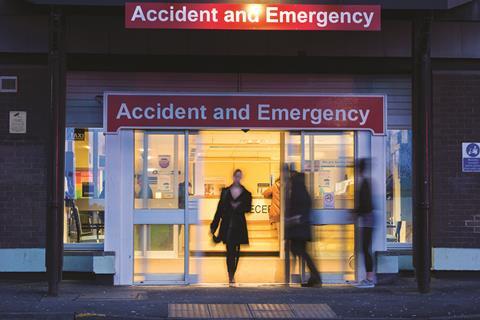Health service spending on building maintenance and repairs faces a £4.3bn backlog. But there is good news for the construction industry

The economy has been in such a tailspin since last month’s Brexit vote that the NHS suddenly looks like an island of relative calm.
But the health service will be lucky to escape the contraction in public spending that most commentators predict will follow the UK’s withdrawal from the EU, and NHS budgets were already under pressure before the referendum.
Health spending has been growing in line with inflation since 2010, yet this rate of increase can’t keep pace with an ageing population’s rocketing demand for health services, let alone the cost of new drugs and equipment that tends to rise faster than inflation.
So it’s hardly surprising that NHS repairs and maintenance budgets have felt the pinch since the above-inflation increases of the New Labour era ended around the start of this decade. Over the last five years, non-private finance initiative (PFI) maintenance capital spending has broadly flatlined at around £4bn a year, according to an analysis published in March by Arcadis.
And figures recently supplied by former junior health minister George Freeman to parliament show the cost of remedying the NHS’ maintenance backlog has grown by 7.8% in the last four years. In 2011/12, trusts reported a total backlog of £4bn, which had increased to £4.3bn by 2014/15.
So is this spending gap set to continue to widen? Or will the government and NHS trusts make moves to remedy this long-term underinvestment?
NHS trusts are having to divert funds from capital investment and even refurb and maintenance to ensure they are delivering the best standards of care
Jonathan Puddle, Aecom
A poor prognosis
Dean Sheehy, healthcare sector oversight director for Rider Levett Bucknall, says of recent NHS spending: “The trend isn’t good. The trusts we work for have a backlog maintenance issue that is getting no better.”
More worrying is that these overall figures mask proportionately higher rises in the cost of eradicating the most serious backlogs. The cost of dealing with high-risk backlogs, such as leaking roofs, increased by more than 50% from 2011-12 to 2014-15, from £296m to £458m.
Conor Ellis, head of health at consultancy Citrica, says. “Despite the investment, we don’t seem to be getting a grip on the high-risk elements, which are not coming down to the sort of levels you would expect.”
Any backlogs are likely to have been exacerbated as a result of last winter’s decision by the Department of Health to claw back capital programme underspends to help plug wider trust deficits. And it’s likely to get worse; Roger Pulham, head of healthcare at Gleeds, says it is “ludicrous to assume” that the backlog won’t have been adversely affected by Brexit.
Simon Corben, managing director of Capita Health Infrastructure, says that the repairs and maintenance picture across the NHS is patchy. Trusts with older stock will face relatively expensive maintenance bills, and despite the largesse showered on the NHS from 2000 to 2010, Arcadis’ analysis shows that nearly one-fifth (18.3%) of the health service estate pre-dates the NHS’ foundation in 1948.
Those trusts that just missed the PFI boat are often in the worst shape, says Corben: “Some estates that were due to be PFIs are struggling the most.” In addition, trusts that took part in PFI projects can tap into dedicated maintenance cash under contracts with providers.
Elsewhere, building budgets often lose out to frontline care in the competition for increasingly squeezed spending.
Jonathan Puddle, head of healthcare at Aecom, says: “NHS trusts are having to divert funds from capital investment and even refurbishment and maintenance into operational business to ensure they are delivering the best standards of care.”
Gleeds’ Pulham agrees: “The first thing that tends to get cut is capital investment and after that it’s the backlog maintenance budgets.
“If it’s not prejudicial to the health and wellbeing of users and doesn’t put the CEO at risk of jail, they will take a more measured stance.”

Trusts, though, run the risk that problems will build up into a crisis, warns RLB’s Sheehy. “If that money isn’t spent, you are getting close in certain instances to having to close parts of hospitals.” Puddle adds: “In the long run, that has a knock-on effect, because you will spend more money later on down the line.”
And while it is no doubt tempting to prioritise frontline care, Ellis reminds NHS bodies that they have a duty of care to provide a safe and secure environment for staff and patients.
Helen Davis, head of health at Arcadis, says NHS bodies also face pressure from the Care Quality Commission (CQC) to ensure facilities are kept up to scratch. Ensuring that premises are clean, secure, and fit for purpose is one of the benchmarks the healthcare regulator uses to grade trusts.
The CQC’s power to mark down trusts as failing is taken extremely seriously by NHS chief executives, says Davis, who worked in health service estates before joining Arcadis.
Trusts can save on unnecessary maintenance by getting rid of under-used or unoccupied space, she says: “If you make better use of buildings, you can release assets that are under-utilised and therefore don’t have to invest in those assets. That money can then be diverted into maintaining assets you are retaining to an acceptable standard.”
The healing process
This process is already under way thanks to the government’s NHS-wide efficiency programme.
Robert Naylor, chief executive of University College London NHS Trust, is due to report on a review of the health services estate in the autumn. Meanwhile across England, 44 Sustainability and Transformation Plans are being drawn up, which are likely to lead to a significant reshaping of local NHS services.
If you have a surgeon operating out of a room 95% of the time, it’s not a problem. If it is two or three times a week there is a meaningful debate about how that could be used
Conor Ellis, Citrica
These plans will probably recommend moves such as merging duplicated services into regional centres of excellence for specialities like heart surgery, which will have the knock-on effect of liberating space.
Ellis believes there is plenty of scope, too, for greater sharing of back-office services, pointing out that the proportion of floorspace used for management offices varies from 4% to 12% across NHS trusts.
In addition, the NHS as a whole could make up to £1.5bn in savings a year by rationalising its estates and improving facilities management, estimates Ellis, who recently left Arcadis.
But this will require difficult choices, he adds. “If you talk to the accountants, they want to make the savings without putting in the investment. If you talk to the people on the estates side, they want all the investment but don’t want to take the difficult decisions they need to make to bring operating costs down.”
Often the problem lies in vested interests, such as persuading consultants they don’t need the dedicated treatment rooms they only use a handful of times a week.
“If you have a surgeon operating out of a room 95% of the time, it’s not a problem. If they are operating out of a room two or three times a week, there is a meaningful debate about how that could be used,” says Ellis, who recalls working in hospitals where the same professor might have offices on three separate sites. “With the greatest respect, even they can only be in one place at one time.”
Better use of space could create parcels of land that can be sold to help plug gaps in NHS trusts’ balance sheets, perhaps through joint ventures with developers or contractors.
Alternatively, it could free up space for new facilities, such as separate and more specialised accident and emergency facilities for women and children.
Lewis Parker, healthcare director of Kier, says these new facilities could include a generation of new “transitional wards”. These would provide rehabilitative care for the growing army of mainly elderly patients, who block expensive acute care beds because they are unable to look after themselves in their own home.
Even if it escapes the worst buffeting from the post-Brexit fallout, it is clear that the NHS estate faces considerable change over the next few years - it is hoped, for the better.
Winning NHS work
The health service remains an important market for construction companies even if the halcyon days of the private finance initiative (PFI) may be an increasingly distant memory.
The ProCure 22 framework, which has attracted 13 prospective bidders, will be worth an estimated £4.5bn for the six companies that are due to be selected next month. The new framework, covering a gamut of work ranging from small new-build projects to refurbishment and maintenance, is set to go live in early October.
“You won’t get rich on it, but the pipeline will always be there,” says Kier’s Parker, whose company netted a greater share of the contracts procured through P22’s predecessor framework P21 than any of its contractor rivals.
“In the recession [the contractors] would kill to have an opportunity to get into a health project,” says Gleeds’ Pulham.
But NHS work isn’t for the fainthearted, says Capita’s Corben: “It’s a hard market to get involved in because of its specialised nature and the investment it requires contractors to make.”
It’s technically challenging work with the added complications involved in working closely alongside groups like patients and medical professionals, adds Parker.
PF2, the coalition government’s son of PFI initiative, has, however, proved to be a bit of a damp squib. While there are reckoned to be about half a dozen hospitals that would benefit from wholesale PFI-style replacements, Aecom’s Puddle sees “no great appetite” for PF2, mainly because of the tighter spending climate that the NHS now operates in.
Only one significant NHS project has been procured so far via PF2, the Midland Metropolitan Hospital being built in the Black Country borough of Sandwell.
And even this project required a Herculean political act to get off the ground, says Puddle: “Had it not been for the prime minister, the chancellor of the exchequer and the chief executive of NHS England going on to local TV stations outlining their commitment, it would have been highly unlikely to cross the line.”



























No comments yet